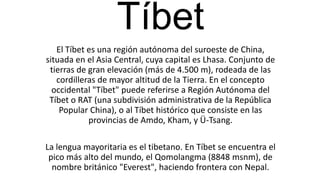
Tíbet
- 1. Tíbet El Tíbet es una región autónoma del suroeste de China, situada en el Asia Central, cuya capital es Lhasa. Conjunto de tierras de gran elevación (más de 4.500 m), rodeada de las cordilleras de mayor altitud de la Tierra. En el concepto occidental "Tíbet" puede referirse a Región Autónoma del Tíbet o RAT (una subdivisión administrativa de la República Popular China), o al Tíbet histórico que consiste en las provincias de Amdo, Kham, y Ü-Tsang. La lengua mayoritaria es el tibetano. En Tíbet se encuentra el pico más alto del mundo, el Qomolangma (8848 msnm), de nombre británico "Everest", haciendo frontera con Nepal.
- 2. Economía La economía de Tíbet se ha basado tradicionalmente en actividades tradicionales como, la agricultura, la ganadería, la hilandería de lana, la silvicultura y la artesanía. Recientemente se han descubierto en Tíbet modestos yacimientos de cobre, plomo, zinc, cromo, oro, aluminio y petróleo, lo que ha hecho que diversas empresas, tanto nacionales como extranjeras se hayan interesado en hacer estudios más amplios en la zona. Tíbet posee además uno de los cinco únicos yacimientos de litio en el mundo, material usado en medicina, industria pesada y recientemente en baterías de coches eléctricos y dispositivos informáticos móviles, lo que lo convierte en un yacimiento estratégico.
- 3. Gastronomía A causa de la gran altitud y las duras condiciones ambientales del Tíbet, su gastronomía es muy rica en calorías, proteínas y grasas. La alimentación diaria de los nómadas tibetanos se basa en dos alimentos muy energéticos: la tsampa, que consiste en harina generalmente de cebada tostada al fuego, y el té tibetano (chas), que es té con mantequilla de yak y sal. Otros platos más elaborados son, por ejemplo, el Thukpa (sopa de verduras, carne y pasta) y el momo (pasta con forma de ravioli —de un tamaño más grande que una croqueta— rellena de carne o verdura, hechos al vapor), así como los khabse (galletas). Igualmente se come carne de yak, oveja o cabra. También aprovechan la leche para hacer lassi, yogur batido y un poco de miel con carne de buey.
- 4. Lengua La educación es bilingüe y los niños tibetanos aprenden simultáneamente chino mandarín y tibetano. En la lengua tibetana, las palabras acostumbran a ser monosilábicas aunque se les añade un sufijo que normalmente denomina si es masculino, femenino, plural, verbo, etc. El alfabeto tibetano proviene de la época del rey Songsten Gampo. Este rey (el que introdujo el budismo al Tíbet) envió un grupo de eruditos a la India para que estudiaran los textos budistas y los tradujeran a la lengua tibetana. Asimismo, estos eruditos debían estudiar detalladamente los alfabetos indios. Escogieron el brahmi y, modificándolo, se creó el alfabeto tibetano.
- 5. Budismo El budismo mahayana entró en el Tíbet gracias a Guru Rinpoché en el siglo VIII. Antes existía la tradición Bön. Con el auge del budismo, la antigua tradición casi desapareció, aunque más tarde fue recuperada y se fundaron 300 monasterios. Parte de la creencia Bön creó el budismo tibetano. La tradición Mahayana o Gran Vehículo no se limita a buscar la liberación personal, sino que tiene como finalidad expandir la sabiduría lograda y enseñar el camino a todos los seres. Este vehículo toma diferentes formas según las culturas: el Zen en Japón, el Tantra o Vajrayana en Tíbet.